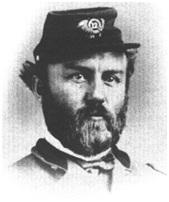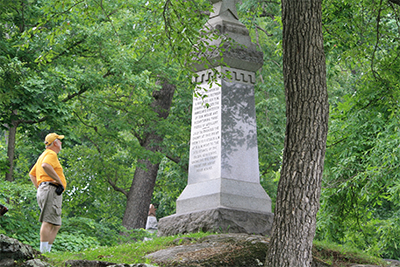The Glorious 12th Infantry Regiment
The Glorious 12th Infantry Regiment
By Arnold Krause, SSG, Vietnam
“The numerical designation " Twelfth" has been borne by four regiments of infantry in the regular service of the United States. The first was organized July 16, 1798, under an act of same date, and disbanded June 15, 1800. The second and third were raised temporarily during hostilities, the former in 1812, its personnel being chiefly from Virginia, the latter during the Mexican War. Both performed well the duty for which intended, and upon the cessation of hostilities were disbanded.
The present regiment was organized by direction of President Lincoln in a proclamation dated May 4, 1861. An act of Congress of July both of the same year confirmed the organization. It was to  consist of three battalions of eight companies each. The organization was commenced in August, Major Clitz in charge of recruiting, headquarters at Fort Hamilton, New York Harbor. On October 20th the first battalion was organized, and the return of that month shows an aggregate of 520, the companies averaging each about 60 men.” (LT Charles Abbot, Jr.)
consist of three battalions of eight companies each. The organization was commenced in August, Major Clitz in charge of recruiting, headquarters at Fort Hamilton, New York Harbor. On October 20th the first battalion was organized, and the return of that month shows an aggregate of 520, the companies averaging each about 60 men.” (LT Charles Abbot, Jr.)
The war history of the 1st battalion 12th Infantry, indeed of the 2d also, is inseparable from that of "Sykes's Regulars," for the 2d joined the 1st in September, 1862. They remained together until so reduced in numbers that the 2d was merged into the 1st. Where ever that splendid command was engaged the 12th Infantry did its full share. It seemed that in each major conflict the 12th found itself anchoring the middle of the skirmish line.
The 12th Regiment’s first real engagement at Gaines’ Mills in “Sykes Regulars” command resulted in a total loss of 212, 54 of these were killed, 102 wounded and 56 missing out of a battle force of 470 strong. “Regulars” was used to differentiate between enlisted men and the volunteer forces of the Union Army. The list of engagements that the 12th fought in during the war is long. From Peninsula, Manassas, Antietam, Fredericksburg, Chancellorville, Gettysburg, Wilderness, Spotsylvania, Cold Harbor, to Petersburg including credit for campaigns in Virginia 1862 and 1863.
On November 2, 1864, the Regiment left Virginia and Popular Grove Church for Fort Monroe, hence to New York via Norfork with 48 men, in order to be rebuilt. The statistics of losses during the period of 1862-64 show that of all the regular regiments the 12th stands fourth in the total of deaths including killed, died of wounds, disease, or in prison. The number that died in prison, 77, exceeds that in any other regular regiment, and indeed is one of the largest in the entire army.
Following the end of the war, the 12th Regiment finally completed the creation of the 3rd battalion in 1866. During the War, the volunteer units serving far outnumbered those of the regular army. The thought of enlisting and the pay that was received was not enough of an attraction to fill out all the allotted battalions with a full complement of men. For those officers assigned recruiting duties the struggle continued throughout the war.
Following a move in 1868 to South Carolina and further southward to Alabama and Georgia during reconstruction the 12th Infantry beginning in early 1869 began to move west by rail and found itself beyond the frontier of the west and scattered over three states or territories, California, Nevada and Arizona occupying eleven different posts. They were involved in the Indian Wars of the 1870’s engaging the Modoc Tribes, then the Nez Perces in an effort to stabilize the West. They were credited with three campaigns, Modocs in California, Bannocks in Oregon and Idaho and later when they were dispatched to the Dakota’s, the Pine Ridge campaign. They remained in the West having visited most of the western states during this period in pursuit of the Indians. They would continue to police the west, dealing with the Apache, and Sioux nations which lasted until 1892.
“In October of 1892, a detachment from the Regiment was sent from Ft Leavenworth which took part in the dedicatory exercises of the World’s Fair in Chicago. While there, a gentleman seeing the regimental colors, introduced himself to the adjutant as an ex-sergeant, who had served in the regiment during the ’64 campaign, and told many interesting reminiscences. Finally he produced a small package, which he carefully undid, showing a much defaced gilt star and saying –“you may look at, but not touch that. It is one of the last two stars remaining on the battle flag. In front of Petersburg another sergeant and myself cut them off, and each took one. I think everything of it”. This incident indicates a lesson of devotion to the principles of duty of which the flag is emblematic, that may well be taken to heart by all who now, or may hereafter, serve under the colors of the 12th Infantry. They will have the proud consciousness of the fact that the regiment has done its duty in the past. It only remains for them to sustain that reputation in the future.” (LT Charles Abbot, Jr.)
In 1898 the Regiment is ordered and dispatched to Georgia to prepare for the War with Spain. The Regiment participated in the storming of the Spanish fortress in the Battle of El Caney where they captured the Spanish colors in Santiago, Cuba, earning another campaign ribbon then was sent west to deal with the Philippine Insurrection of 1899 and after three more campaigns there, returned to the U.S. in 1902 for a brief period before once again is sent back to the Island of Luzon until 1906.
Some quiet years followed for the 12th. The U.S. Army reformed itself in the second decade of century and the unit found itself assigned to the 8th Division. The Regiment underwent rigorous training but never got involved in World War 1. After a long period of peace the 12th Regiment is assigned to the 4th Infantry Division in October of 1941. The Regiments first involvement in the 2nd World War is on June 6th, D-Day, 1944 as they wade ashore at Utah Beach. The 12th is the first American unit to enter Paris and later is awarded the Presidential Unit Citation for its involvement in the Battle of the Bulge defending Luxembourg from the German Army. They crossed over into Germany and pushed southeast bypassing Heidelburg on a course that would carry them across the Danube River and place them below Munich and just above the Bavarian Alps where they are relieved by the 101st Airborne in April 1945, then soon after, are sent home. They are credited with five campaigns.
After the war ended, the 12th found itself, for the first time since being constituted in 1861, being inactivated. After Belgium gave the 12th Infantry the Belgian Fourragere, it was written somewhere in the language of the citation that the regiment must “have been led by love of country” to carry out its mission in defending Belgium and Luxembourg. It is from this citation that the Regiment adopted its official motto, Ducti Amore Patriae, “Having Been Led By Love Of Country”.
The Regiment is assigned to the 4th Infantry Division in 1963 and in October, 1966 finds itself wading ashore in Vietnam. The Regiment is the only unit to have five battalions fighting in Vietnam and earns 11 campaign ribbons plus three Presidential Unit Citations before they return home in April of 1971 and once again are deactivated.
After various assignments in Europe during the Cold War with Russia and after a period of calm that extended beyond 1995, the 12th Infantry Regiment is once again called into battle in 2006, fighting terrorism while serving in both Iraq and Afghanistan theatres, being deployed numerous times to each country which has continued up to November, 2016. The War on Terror campaign continues and the 12th Infantry Regiment remains a vital element of the 4th I.D. as the go to Division of the U.S. Army.
The 12th Infantry “Warriors” Regiment is a highly decorated unit during its history, fighting in seven wars and has been credited with four Presidential Unit Citations, six Valorous Unit Citations, seven Meritorious Unit Citations, Army Superior Unit Award, the Belgian Fourragere 1940 and three Vietnamese Cross of Galantry with Palm Unit Citations, Republic of Vietnam Civil Action Honor Medal, First Class and 39 campaign ribbons. The Regiment currently has 13 Medal of Honors awardees.
To honor the men who have so faithfully served in this unit, the 12th Infantry Regiment Chapter of the 4th Division is raising funds to place a monument in the Walk of Honor at Ft Benning, Georgia. The Dedication ceremony will take place on May 31, 2017 at 1PM. Further information regarding donating to this memorial monument or details about the scheduled dedication event can be found by accessing this link www.4thinfantry.org/news. The Walk of Honor is located behind the National Infantry Museum and Soldier Center, a site dedicated to the foot soldier of the U.S. Army.
Disclaimer: Information written in this article has been credited to LT Charles Abbot, Jr, Adjutant 12th U.S. Infantry, Center for Military History and from the book, Twelfth U.S. Infantry 1798-1919 copyright 1919, written by the men of the unit.


